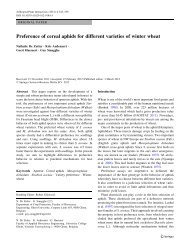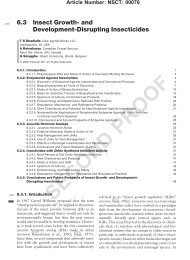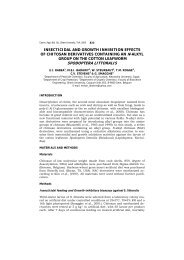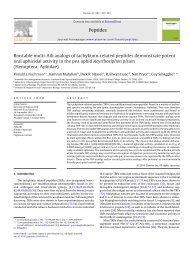Action of a novel nonsteroidal ecdysteroid mimic ... - Insects.ugent.be
Action of a novel nonsteroidal ecdysteroid mimic ... - Insects.ugent.be
Action of a novel nonsteroidal ecdysteroid mimic ... - Insects.ugent.be
You also want an ePaper? Increase the reach of your titles
YUMPU automatically turns print PDFs into web optimized ePapers that Google loves.
90 Guy Smagghe, Danny Degheele<br />
P<br />
‘3<br />
350<br />
-m-<br />
5 150<br />
5<br />
0 100<br />
04 I<br />
0 5 10 15 20<br />
Time (days after first oviposition)<br />
Fig. 4. Effect <strong>of</strong> tebufenozide on the cumulative fecundity per<br />
female <strong>of</strong> L. decemlineata adults, at 20 pg per adult by topical<br />
treatment and at 30 or 100 mg litre-’ by continuous feeding<br />
on treated potato leaves. The arrow indicates the moment when<br />
topical treatment took place or oral application started. The<br />
symbol * indicates that all adults were dead.<br />
73( k 8) and 69( k 8)% for the groups treated topically<br />
with 0 and 20 pg per adult, respectively.<br />
3.3 Toxicity and effect <strong>of</strong> tebufenozide on Heteroptera<br />
No effect on growth, weight gain or ecdysis was observed<br />
on third- (N,) and last- (N5) instar nymphs <strong>of</strong> P. sagitta<br />
at doses ranging from 1 to 40 pg per nymph, topically<br />
applied either on the dorsal or on the ventral side.<br />
Likewise, no toxicity and no effects on the development<br />
<strong>of</strong> N, and N, bugs were noted when last-instar S. exigua<br />
larvae previously treated with 20 pg per larva were<br />
provided as prey.<br />
In a preliminary assay with 0. insidiosus, no effects on<br />
the development <strong>of</strong> any nymphal stage (N,-N,) or adult<br />
formation were noted when fresh eggs <strong>of</strong> S. exigua<br />
previously dipped in 1 g litre-’ tebufenozide were<br />
supplied ad libitum.<br />
3.4 Toxicity and effects <strong>of</strong> tebufenozide on Orthoptera<br />
First- and second-instar L. migratoria migratorioides<br />
larvae showed a pattern <strong>of</strong> growth and ecdysis into the<br />
following instar after a continuous treatment with 30 or<br />
100 mg litre-’ tebufenozide which was the same as that<br />
<strong>of</strong> the control insects.<br />
4 DISCUSSION<br />
Tebufenozide acts primarily by inducing a premature and<br />
lethal larval moult, especially in larval Lepidoptera. Our<br />
results strengthen the concept that the compound<br />
stimulates epidermal cells to undergo apolysis prematurely<br />
and to synthesize a new larval cuticle by imitating the<br />
activity <strong>of</strong> <strong>ecdysteroid</strong>s. In addition, LC50 values <strong>of</strong><br />
tebufenozide against the different stages <strong>of</strong> S. exempta<br />
and S. exigua illustrate the uniformity <strong>of</strong> response with<br />
respect to the larval stage, which is consistent with the<br />
pattern <strong>of</strong> RH-5849 against the different stages <strong>of</strong> several<br />
Lepidoptera obtained under comparable conditions.2*’2<br />
The minimum concentration <strong>of</strong> tebufenozide (by means<br />
<strong>of</strong> a continuous oral application) needed to induce a<br />
premature moult in the different larval instars was similar<br />
for each species: in third- to sixth-instar larvae (L3-Ls)<br />
<strong>of</strong> S. exempta at a concentration <strong>of</strong> 20.02 mg litre-’, and<br />
in L1-L5 <strong>of</strong> S. exigua at 21 mg litre-’. LC50 values for<br />
last instars reached lower levels, since abnormal and<br />
lethal pupation are included in the mortality percentages<br />
for last-intar larvae.<br />
The inability <strong>of</strong> treated larvae to ecdyse out <strong>of</strong> the old<br />
cuticle might <strong>be</strong> provoked by an interference with<br />
eclosion hormone (EH) production/release, since it is<br />
known that this hormone is released by a drop in<br />
<strong>ecdysteroid</strong> titre prior to ecyd~is.~~ Residual amounts <strong>of</strong><br />
<strong>ecdysteroid</strong> agonist in the insect body may cause an<br />
inhibition <strong>of</strong> EH-release. Similar results <strong>of</strong> death during<br />
a prematurely promoted moult have <strong>be</strong>en reported<br />
previously, following application <strong>of</strong> natural <strong>ecdysteroid</strong>s<br />
to different insect species.31<br />
The decrease in weight gain and feeding in larval<br />
Lepidoptera treated with tebufenozide may result from<br />
an ecdysonergic activity <strong>of</strong> the compound. It is well<br />
known that cessation <strong>of</strong> feeding and weight gain occurs<br />
prior to ecdysis as a result <strong>of</strong> <strong>ecdysteroid</strong> ~ecretion.~’ In<br />
contrast, no such effects were observed in larvae <strong>of</strong> L.<br />
decemlineata, D. virggera, P. sagitta and L. migratoria at<br />
similar doses/concentrations <strong>of</strong> te<strong>be</strong>nufenozide.<br />
The different toxicities <strong>of</strong> <strong>ecdysteroid</strong> agonists on<br />
last-instar larvae <strong>of</strong> S. exempta, S. exigua and L.<br />
decemlineata applied orally cannot <strong>be</strong> explained by<br />
differences in retention, distribution and metabolic<br />
detoxification <strong>of</strong> the compound in the insect body.”,33<br />
Consequently, we consider that the wide range <strong>of</strong><br />
susceptibilities to the <strong>ecdysteroid</strong>-<strong>mimic</strong>king compounds<br />
in the different insect species may <strong>be</strong> explained by<br />
differences in the structure <strong>of</strong> the EcR and their binding<br />
affinity for the <strong>ecdysteroid</strong> agonist ligand molecules. The<br />
latter hypothesis is consistent with the concept that<br />
structure and biochemical properties <strong>of</strong> EcR may differ<br />
among insect species.34 In general, although the hypothesis<br />
seems reasonable that the different toxicities <strong>of</strong><br />
<strong>ecdysteroid</strong> agonists are induced by differences in<br />
EcR-binding affinity, further research is required.<br />
In this study, it was noted that tebufenozide possessed<br />
little or no insecticidal activity against larvae <strong>of</strong> two<br />
coleopterans, L. decemlineata and D. virgqera virgqera,<br />
against various nymphal stages <strong>of</strong> the predatory heteropterans,<br />
P. sagitta and 0. insidiosus, or against larvae<br />
<strong>of</strong> the orthopteran, L. migratoria migratorioides, as









